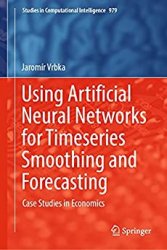Using Artificial Neural Networks for Timeseries Smoothing and Forecasting: Case Studies in Economics
- Добавил: literator
- Дата: 5-09-2021, 16:30
- Комментариев: 0
 Название: Using Artificial Neural Networks for Timeseries Smoothing and Forecasting: Case Studies in Economics
Название: Using Artificial Neural Networks for Timeseries Smoothing and Forecasting: Case Studies in EconomicsАвтор: Jaromír Vrbka
Издательство: Springer
Серия: Studies in Computational Intelligence
Год: 2021
Страниц: 197
Язык: английский
Формат: pdf (true), epub
Размер: 64.9 MB
The aim of this publication is to identify and apply suitable methods for analysing and predicting the time series of gold prices, together with acquainting the reader with the history and characteristics of the methods and with the time series issues in general. Both statistical and econometric methods, and especially Artificial Intelligence (AI) methods, are used in the case studies. The publication presents both traditional and innovative methods on the theoretical level, always accompanied by a case study, i.e. their specific use in practice. Furthermore, a comprehensive comparative analysis of the individual methods is provided. The book is intended for readers from the ranks of academic staff, students of universities of economics, but also the scientists and practitioners dealing with the time series prediction. From the point of view of practical application, it could provide useful information for speculators and traders on financial markets, especially the commodity markets.
There is no doubt that artificial neural networks (ANN) have been attracting the attention of a large number of scientists, experts and the uninitiated from all over the world for many years. It is so due to their ability to imitate the central nervous systems of living organisms in a far better way than previous techniques. The artificial neural network is currently an essential concept which Vochozka considers as an algorithm imitating the human brain. The author further argues that artificial neural networks rank amongst non-parametric, flexible instruments based on historical data and the ability to predict the future. Hamid and Habib define neural networks as a flexible and reliable field composed of principal and dominant elements—neurons. They allow the connection of various neural inputs and outputs, benefits, inhibition, while minimizing the influence of the defective neuron on the result.
According to Olej, RBF (Radial basis function) networks are so-called three-layer neural networks. The first layer (input layer) is intended for the transmission of input values. The second one is the hidden layer, which consists of RBF units performing individual radial basis functions (RBF). The last (third) layer is the output layer, which usually has a linear character. Like MLP, RBF neural networks are also feed forward neural networks. In this type of network, the signal is transmitted from the inputs through the hidden to the output layer. For good network functionality, it is necessary that all neurons are connected in all layers. This means that neurons in adjacent layers are interconnected so that the out of one neuron is distributed in the inputs of neurons in the following layer. Gubana (2015) adds that the parameters of neural networks indicate the number of neurons and layers, depending on the nature of a relevant problem.
Contents:
Скачать Using Artificial Neural Networks for Timeseries Smoothing and Forecasting: Case Studies in Economics
[related-news] [/related-news]
Внимание
Уважаемый посетитель, Вы зашли на сайт как незарегистрированный пользователь.
Мы рекомендуем Вам зарегистрироваться либо войти на сайт под своим именем.
Уважаемый посетитель, Вы зашли на сайт как незарегистрированный пользователь.
Мы рекомендуем Вам зарегистрироваться либо войти на сайт под своим именем.

